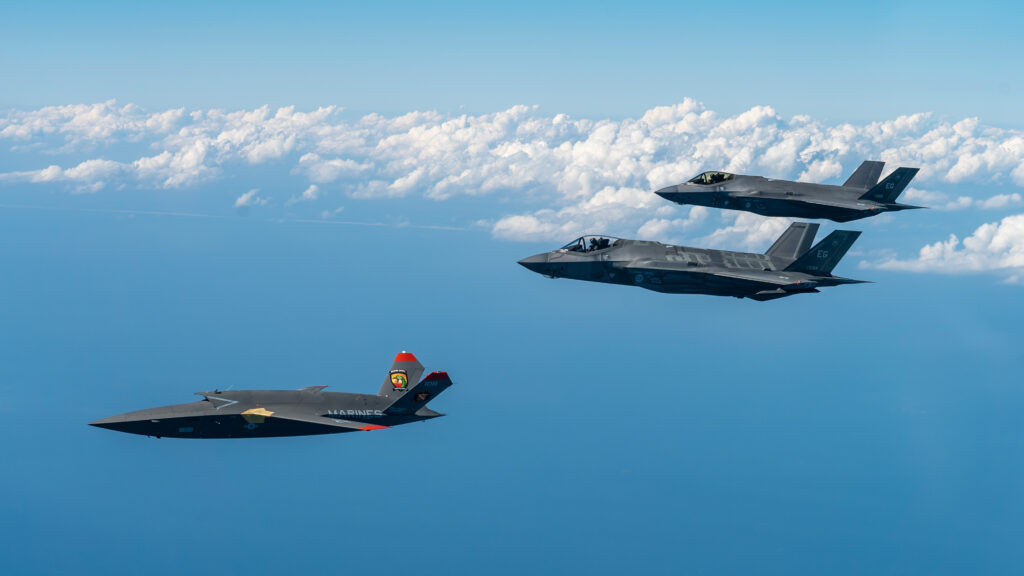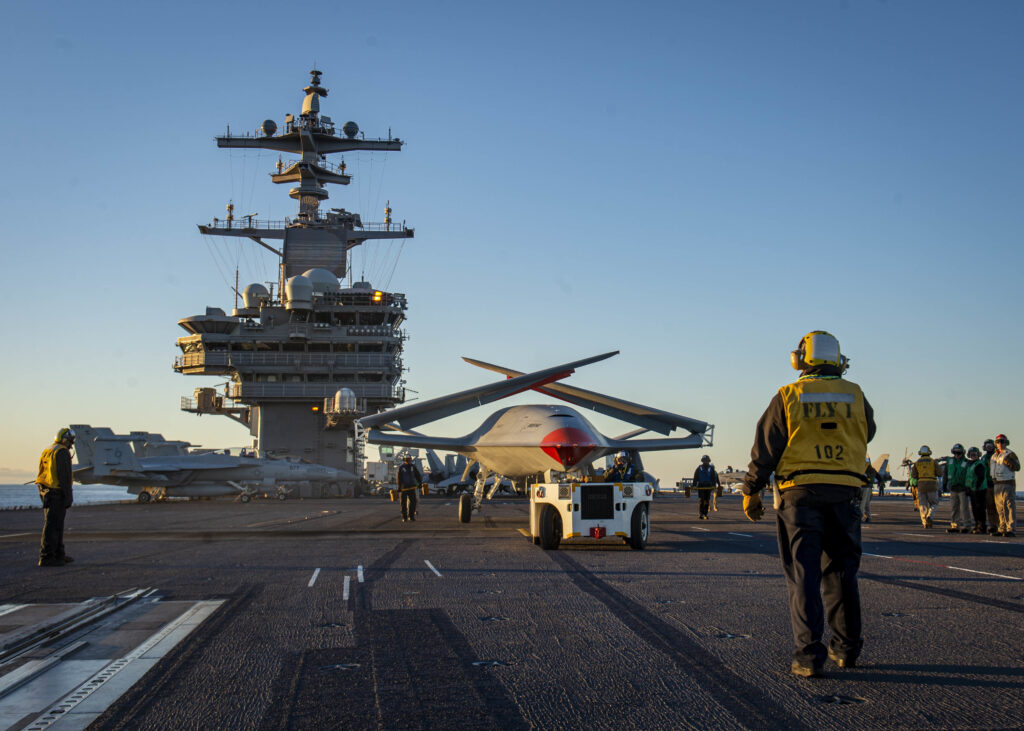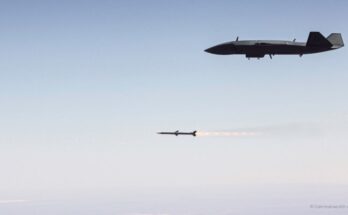
Recent months have produced a blur of activity in the Collaborative Combat Aircraft (CCA) market segment, most notably with developments related to the Air Force’s CCA or drone loyal wingman program. CCAs are large, typically group 5, semi-autonomous UAS that share similar performance characteristics with crewed fighters and will operate alongside, enhancing mission capabilities and adding relatively affordable mass to fleet force structures.
While the CCA acronym belongs to U.S. Air Force efforts, the term is becoming more ubiquitous as related initiatives take shape. CCA efforts across the globe are making progress, causing a shift in resources and attention toward the rapidly changing landscape.
In the U.S., as the military explores the tactical and strategic potential for these systems, both traditional prime airframe manufacturers and newer challengers have debuted concepts, achieved milestones, and catalyzed sub-tier offerings.
USAF CCAs
Umbrellaed under the Next Generation Air Dominance initiative, the objective of the Air Force’s CCA program is to field cost-effective UCAVs to accompany in-service F-22s and ultimately F-35s and future F-47 crewed fighter aircraft. Initially, these semi-autonomous AI-enabled drones will act as missile trucks capable of performing ISR, electronic warfare, and other mission profiles with quarterbacking from the human-piloted fighter.
The CCA program involves two increments; the first focuses on initial service introduction, and the second will likely refine and expand the capabilities, partners, and compatibility.
Two industry players, General Atomics Aeronautical Systems, Inc. (GA-ASI) and Anduril, are competing for increment one with their respective offerings, the Gambit 2-influenced YFQ-42A, and the Fury YFQ-44A. RTX builds the autonomy software for the YFQ-42A, while Shield AI supports Anduril’s YFQ-44A.
GA-ASI’s single-engine YFQ-42A notched the first CCA flight through remote piloting on August 27, with a second prototype flight sortie a little over a month later, combined with an announcement that the model was “in rate production.”
The V-tail CCA features stealth design, a top-mounted engine intake, an internal weapons bay, and tricycle-type trailing arm landing gear to enable operation from less-prepared runway surfaces.
Anduril’s YFQ-44A completed its maiden flight on October 31, roughly two months behind the YFQ-42A. Notably, Anduril’s prototype flew semi-autonomously, demonstrating its focus on software maturity.
The YFQ-44A incorporates some stealth characteristics, a bottom-mounted engine air intake, and a single tail design. Anduril’s leadership previously said the tricycle landing gear design allows for manufacture in “any machine shop in America.”
For propulsion, the aircraft features a commercial off-the-shelf business jet engine. YFQ-44A appears designed to carry weapons from external hardpoints rather than an internal weapons bay; a decision presumably made to trade off stealth performance for affordability.
Funding allocations for the USAF CCA program have grown over the past few years with a 100 percent increase from FY24 to FY26, underscoring the service’s ambition to accelerate development. The Air Force has said it plans to procure between 100 and 150 units in the first phase, with a total program goal of roughly 1,000 to 2,000 aircraft.

Affordability remains a significant factor in procurement levels; recurring estimates place CCA unit cost at between $25 and $30 million, or approximately one-third the cost of an advanced fighter jet. But that figure may be shifting. Last summer, General Atomics said its aircraft would cost “far less than $20 million.” Although Andruil has not publicly discussed pricing for the YFQ-44A, the focus on landing gear simplicity and the lack of an internal weapons bay suggest it could undercut General Atomics’ price point.
The Air Force plans to move forward on a production award during FY26 that could include either or both competitors. With the selection of a traditional and newer player to build CCA prototypes, a decision to carry the same competitive model into the production phase makes sense. This could allow acquisition officials to evaluate each company’s manufacturing, cost, and delivery performance side-by-side while also giving the newly formed Experimental Operations Unit two different platforms to test against its tactical and conceptual CCA goals.
USN CCAs
The U.S. Navy continues to make headway on its own CCAs, though overall the effort is more latent than the Air Force’s program. The naval service’s carrier launch and recovery requirement adds challenges for a loyal wingman system intended to “enable” F/A-18 and F-35C aircraft and “complement” the expected sixth-generation F/A-XX fighter.
Navy CCAs are more likely to fill intelligence, surveillance, and reconnaissance (ISR) and air-to-surface strike roles. Yet, specific mission objectives remain unclear as the nascent F/A-XX initiative will likely drive the USN’s CCA outlook.
Indeed, the same industry partners are at work on the naval program. Earlier this year, reports showed that Anduril, Boeing, General Atomics, and Northrop Grumman received contracts for “conceptual designs”, and Lockheed Martin’s Skunk Works is under an agreement to advance the common control system with the MDCX autonomy platform. Shield AI, already sourced for autonomous work on the Anduril YFQ-44A, also successfully flew a BQM-177A in September that “may inform” Navy CCA plans.
In contrast to Air Force CCA estimates, a senior Navy official said last year that the service aimed for a lower unit cost near $15 million for systems that would fly for a “couple hundred hours” before being used as training targets or one-way attack weapons.

Meanwhile, the U.S. Marine Corps will likely prove out its “first to fight” motto with CCAs as it plans to become the first service branch to procure and operationalize wingman drones. Although the Air Force initiated flight testing the Kratos XQ-58 Valkyrie in 2019, the Marines, who have flown the CCA alongside F-35s, are close to formalizing the XQ-58 as a program of record. Company leadership has said that over a dozen XQ-58s could be delivered “immediately upon contract award.” Accordingly, the Navy’s FY26 request includes $58 million in CCA research and development for the Marine Air Ground Task Forces (MAGTFs).
Analysis
Air Force leaders and analysts continue to sound the alarm that scheduled combat aircraft retirements, industrial base concerns, and insufficient funding jeopardize the service’s ability to meet its intended mission. CCAs offer an opportunity to fight back against these issues.
Based on a series of CCA tabletop exercises, the Mitchell Institute recently found that CCAs, when employed and facilitated correctly, could prove instrumental in contributing to air superiority alongside F-22s, F-35s, and future F-47s against the robust integrated air defense systems (IADs) network in the South China Sea.
Low-cost CCAs complementing advanced manned fighters can provide mission planners with asymmetric options to tie up adversarial resources and maintain pressure between more sophisticated strikes. However, experts argue that success depends on limiting CCA logistics needs and trading future CCA capabilities for rapid procurement.
For this to occur, CCA Increment 1 bidders need to accelerate the timeline, prove their scaling and cost expectations, and deliver fieldable units in the next couple of years.

Navy leadership has previously said that integrating the MQ-25A with the carrier “unlocks” the potential for systems like CCA. Perhaps the overriding challenge of unlocking will be the growing pains of ensuring uncrewed aircraft do not hinder the finely tuned flight deck rhythm. Shipboard sortie rates and aircraft launch and recovery cycle efficiency remain a cornerstone of naval aviation effectiveness. These tempos will need to be maintained–or ideally improved–by adding uncrewed airborne systems into the mix.
On the industry side, developments are mounting quickly. The past two months have revealed significant work or announcements from Lockheed Martin, Shield AI, and Northrop Grumman on potential forthcoming CCA variants. During the same timeframe, propulsion suppliers Honeywell, Pratt & Whitney, and GE Aerospace–looking to capitalize on the momentum–have unveiled new options catered to the CCA and crossover markets.
As with most advanced combat aircraft, propulsion serves as a technological lynchpin for critical performance characteristics like speed, range, endurance, and thermal management. Likewise, operating systems and autonomy software form the backbone of the CCA effort. Watch these developments closely; they will signal the benchmark for success.
A former naval officer and Seahawk helicopter pilot, Jon currently leads the Military Aerospace and Weapons Systems group at Forecast International. He specializes in current and emerging military fixed and rotary-wing aircraft. With over a decade of experience in military aviation, operations, and education, he forecasts a diverse range of defense and naval systems.
Influenced by his time as a former Presidential Management Fellow and International Trade Specialist at the Department of Commerce, Jon gained insights into government operations and global markets.
Before joining Forecast International, he served as an NROTC instructor and Adjunct Assistant Professor at the University of Texas, teaching undergraduate courses in naval history, navigation, defense organization, and naval operations and warfare.



